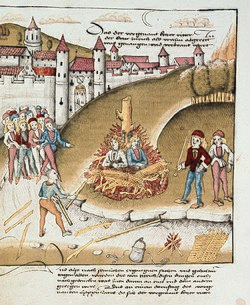Richard Puller von Hohenburg
Richard Puller von Hohenburg (1454 – September 24, 1482)[2] was a 15th-century Alsatian and Swiss nobleman and knight. He is notable for his homosexual liaisons, his strategic avoidance of prosecution, and later execution for his homosexuality.

Biography
Richard Puller von Hohenburg was born in 1454 as the only son to the successful noble Konrad von Hohenburg, descendant of the 13th-century minstrel Der Püller.[3]
In 1463, the Swiss noble Wirich von Berstett captured one of Puller's servants, a man named Ludwig Fischer, after he had been seen dressed in lavish clothes and with more money than his occupation would afford him.[4] In early modern Europe, gifts of clothing were often used as evidence of offering improper sexual services, presented as either a token of love or a bribe from the paying participant.[5] Under torture, Fischer revealed that Puller had romantically pursued him, an act he used to his advantage by blackmailing Puller for money and status.[6] He was consequently stripped of his fiefs, which were transferred to the bishop of Strasbourg, Rupert of Palatinate-Simmern, but Puller was not put on trial. Shortly after, Puller was released from arrest.[7]
Though he had managed to evade prosecution this time, in 1474 Puller was again accused of sodomy. Even against such a severe charge, Puller managed to evade negative consequences through the strategic manipulation of his social status. He procured, or else forged, letters of recommendation from far-off authorities, playing the local Alsatian nobles off against the secular imperial powers of the Holy Roman Empire. By 1476, Puller was released upon a set of conditions: confessing his misdeeds, giving up his properties, and monastic imprisonment. Puller fled from Alsace soon after, stripped of his Alsatian possessions, but did not begin a monastic life.[8]
In 1476, Puller had turned to the Old Swiss Confederacy, then a popular refuge for European criminals, in search of aid in reclaiming his lost properties. He turned to city authorities of Bern for assistance, who rejected his pleas after much deliberation, and after that the authorities of Zürich, who were more obliging and accepted him. Despite this, Puller's claims created some conflict between the Confederacy and the city of Strasbourg, who had historically been a close allies. Over time, Puller's residence became a political nuisance for the city officials, who wished to protect their good relations. In 1482, the city discovered a homosexual relationship between Puller and his servant, Anton Mätzler. This conveniently relieved any political tension surrounding Puller.[9]
Contemporary chronicler Diebold Schilling the Elder reported that, as before, this act had been discovered because of his servant's boasts of the "precious clothing, beautiful shirts, and other treasures" in his possession, which the officials had suspected to be sexual gifts from his master.[10] Puller was charged by the officials with "heresy" (though this was not meant in the modern sense of religious nonconformity, but a medieval sense of sodomy), arrested and then put under torture.[11] Under torture by the city officials, Puller confessed to having had same-sex relationships with Mätzler and several other men. Consequently, he was sentenced to be burned at the stake alongside his servant Mätzler, in the market square of Zurich. On 24 September 1482, a large crowd had gathered to see Puller executed. Puller was asked to repeat his confession, but he refused, instead claiming that the accusation of sodomy was only a cover for the Zurich officials, who wished to seize his land and fortune. One of the officials mentioned by name was Hans Waldmann, then mayor of Zurich, who was later executed for several charges (among them, sodomy) after a spectacular but brief and unpopular political career in Zurich.[12] With the execution of its last scion, the noble family of the von Hohenburgs perished, with its moniker passing on to the Sickinger family.[13]
References
- Smalls 2015, p. 268
- Koymasky 2004
- Franck 1880
- Puff 2002, p. 258, Puff 2003, p. 45
- Puff 2002, pp. 255–56
- Puff 2002, p. 258, Puff 2003, p. 45
- Puff 2003, p. 45
- Puff 2003, pp. 45–46
- Puff 2003, p. 46
- Puff 2002, p. 256
- Koymasky 2004
- Koymasky 2004, Puff 2003, pp. 46–47, Smalls 2015, p. 268
- Franck 1880
Sources
- Franck, Jakob (1880). "Konrad von Hohenburg". Allgemeine Deutsche Biographie (ADB) (in German). 12. Leipzig: Duncker & Humblot. pp. 669–71.CS1 maint: ref=harv (link)
- Koymasky, Andrej (29 June 2004). "Richard Puller von Hohenburg". Matt & Andrej Koymasky Home: The Living Room. Retrieved 12 May 2019.CS1 maint: ref=harv (link)
- Puff, Helmut (2002). "The Sodomite's Clothes: Gift-Giving and Sexual Excess in Early Modern Germany and Switzerland". In McClanan, Anne; Encarnacion, Karen Rosoff (eds.). The Material Culture of Sex, Procreation, and Marriage in Premodern Europe. Palgrave Macmillan. pp. 251–73. ISBN 978-0312240011.CS1 maint: ref=harv (link)
- Puff, Helmut (2003). Sodomy in Reformation Germany and Switzerland, 1400–1600. University of Chicago Press. ISBN 978-0226685052.CS1 maint: ref=harv (link)
- Smalls, James (2015). Homosexuality in Art. Parkstone International. ISBN 978-1783107278.CS1 maint: ref=harv (link)
Further reading
- "Puller de Hohenbourg". Encyclopédie de l'Alsace. 10. Editions Publitotal. 1985. p. 6203-6204.CS1 maint: ref=harv (link)
- Reinle, Christine (1997). "Konflikte und Konfliktstrategien eines elsässischen Adeligen: Der Fall des Richard Puller von Hohenburg († 1482)". In Andermann, Kurt (ed.). "Raubritter" oder "Rechtschaffene vom Adel"? Aspekte von Politik, Friede und Recht im späten Mittelalter. Sigmaringen: Thorbecke. pp. 89–113.
- Ulrichs, Karl Heinrich (1912). "Ein homosexueller Ritter des 15. Jahrhunderts". Jahrbuch für sexuelle Zwischenstufen. 12: 207–30.
- Witte, Heinrich (1895). Der letzte Puller von Hohenburg: Ein Beitrag zur poli-tischen und Sittengeschichte des Elsasses und der Schweiz im 15. Jahrhun-dert sowie zur Genealogie des Geschlechts der Puller [The last Puller of Hohenburg: A contribution to the political and moral history of Alsace and Switzerland in the 15th century as well as to the genealogy of the family of Puller]. Beitrage zur Landes-und Volkskunde von Elsass-Lothringen. 4. Strasbourg.